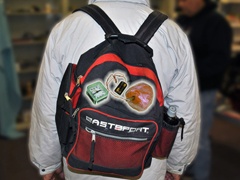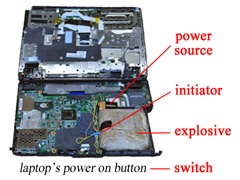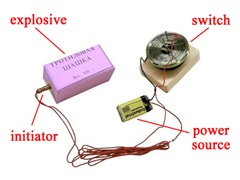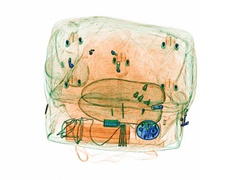 One of the primary weapons of choice for terrorists and lone wolf attackers has been the Improvised Explosive Device, or IED. These dangerous, homemade devices are typically constructed from common household items making them rather inexpensive to build. Nevertheless, IEDs can pack a powerful punch and have been known to cause an extraordinary amount of damage and loss of life.
One of the primary weapons of choice for terrorists and lone wolf attackers has been the Improvised Explosive Device, or IED. These dangerous, homemade devices are typically constructed from common household items making them rather inexpensive to build. Nevertheless, IEDs can pack a powerful punch and have been known to cause an extraordinary amount of damage and loss of life.
Consequently, security checkpoint personnel must always be on high alert for the IED threat. If allowed to pass through a checkpoint, the device will certainly be used with malicious intent. At a fundamental core, security personnel must gain a basic understanding of improvised explosive devices and how they are constructed in order to recognize when one is presented before them.
Variety Among IEDs
There is no one-single type of IED. Explosive devices can be configured countless ways ranging from simple to highly sophisticated. Their shape, size, and design are limited only by the skill and creativity of its maker. IEDs can be deployed on their own, as car bombs, roadside bombs, suicide bombs, or concealed within innocent items. Shrapnel and chemicals may even be used to maximize the blast of an explosion.
Incidents of IED Attacks
 February 2, 2016 – A bomber blew himself out of a passenger plane when his laptop bomb detonated approximately 20 minutes after departing Mogadishu airport in Somalia.
February 2, 2016 – A bomber blew himself out of a passenger plane when his laptop bomb detonated approximately 20 minutes after departing Mogadishu airport in Somalia.
June 12, 2016 – Four passengers suffered minor injuries from broken glass when a man threw a beer bottle explosive device towards an airport check-in counter in Shanghai, China.
June 28, 2016 – Coordinated attacks by three men with automatic weapons and explosive belts in the international terminal of Ataturk Airport in Turkey left over 40 dead and hundreds injured.
July 3, 2016 – A suicide bomber detonated a truck full of explosives in a busy shopping district of Karrada, Iraq ahead of celebrations marking the end of Ramadan, killing 382 people.
July 7, 2016 – A man wounded at least 25 people when he detonated a metal tube filled with an explosive substance on a commuter train approaching Taipei.
The incidents above express how homemade devices can be used in many ways, in different settings, and with varying levels of impact all over the world. In areas where a security checkpoint is or can be established, training for checkpoint personnel is imperative since explosive devices can be difficult to detect without the proper knowledge and skill set.
How IED Components Work Together
 The typical components that make up an IED and how they all function together are two critical pieces of knowledge every security screener should understand. All IEDs typically require the same four components – which can easily be remembered by using the acronym, PIES:
The typical components that make up an IED and how they all function together are two critical pieces of knowledge every security screener should understand. All IEDs typically require the same four components – which can easily be remembered by using the acronym, PIES:
- Power Source
- Initiator
- Explosive
- Switch
The power source provides an electrical charge to the initiator. The initiator contains a small amount of explosive material which triggers the rest of the explosives. The switch (or timer) tells the initiator when to set off the IED in the first place. Some consider the container, which holds everything together, to be the fifth component of an IED.
Examples of each PIES component:
- Power Source – strike anywhere match, watch battery, battery power pack
- Initiator – blasting cap/detonator
- Explosive – TNT, PETN, TATP, semtex, smokeless powder
- Switch – toggle switch, clock, cell phone
- Container – pressure cooker, metal pipe, backpack
Analyzing X-ray Images
 For checkpoints equipped with X-ray systems, understanding how to analyze X-ray images and knowing what to look for is another piece of critical knowledge screening staff must comprehend. Training and practice will be invaluable for teaching what each PIES component will look like under X-ray, what they may look like fully assembled, and how they may be concealed within innocent items.
For checkpoints equipped with X-ray systems, understanding how to analyze X-ray images and knowing what to look for is another piece of critical knowledge screening staff must comprehend. Training and practice will be invaluable for teaching what each PIES component will look like under X-ray, what they may look like fully assembled, and how they may be concealed within innocent items.
With enough practice, X-ray screeners on the job will instinctively ask themselves: Are there red flags or anomalies in this X-ray image? Are there colors and shapes indicative of an IED? Is there a shield blocking a portion of the image? Are all PIES components present, but detached into different areas of the X-ray? And so on.
X-ray screeners must scrutinize anything unusual in X-ray images and if necessary, get a second opinion from a colleague. This is especially important when an item screened daily suddenly displays uncharacteristic features in an X-ray image. You never know when an everyday item has been tampered with.
Conclusion
Improvised explosive devices can certainly be difficult to detect without training and practice. At the very core, all security personnel should recognize the PIES components of an IED, how they work together, and how to analyze X-rays. This critical knowledge can be applied at the checkpoint to prevent a terror attack.

